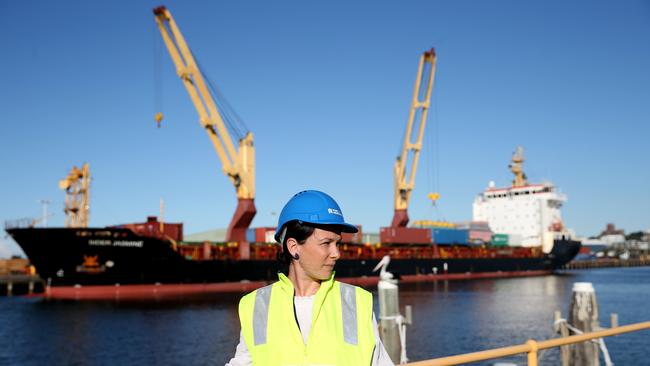Port of Newcastle loan tied to green targets
The Port of Newcastle will be required to meet world-first social and green targets to ensure its long-term viability under a $666m loan facility.

The Port of Newcastle will be required to meet world-first social and green targets — including lowering emissions and screening suppliers for slavery — to ensure its long-term viability under a $666m loan facility.
The National Australia Bank-led syndicate, which stepped in when ANZ abandoned the world’s largest coal export port after adopting a climate-change policy effectively banning loans to the coal sector, has tied $565m in loans with strict sustainability and green measures.
As part of the agreement, the Port of Newcastle will have the opportunity to earn a margin reduction over the next five years on the loans if it hits its social and environmental targets.
The port, co-owned by the Infrastructure Fund and China Merchants Port Holdings Company, will access its new loan facility this week.
NAB’s deal paves the way for future financing agreements with high-emitting clients, after the four major banks last year committed to ambitious climate-change strategies and lending conditions for heavy-polluting companies.
The financial arrangement includes $515m in sustainability linked loans, considered a world-first in aligning with the International Capital Market Association’s Climate Transition Finance Handbook, and $50m in new “green lending” to fund green building projects and diversify the port’s revenue base.
NAB group executive David Gall described the five sustainability linked loan targets as “ambitious” but said he was confident the Port of Newcastle, which supports 9000 jobs and contributes $1.5bn to Australia’s GDP, can “go after achieving these metrics”.
These include keeping greenhouse gas emissions below agreed levels, establishing an Indigenous student internship program with the University of Newcastle, and installing a mental health program.
In an Australian first, the port will also need to screen all existing and new suppliers for “modern slavery risk”.
Mr Gall said there was a “degree of aggression” to incentivise the port to receive the financial benefits associated with the sustainability linked loan component.
“When you’re talking about sustainability it is definitely a broader range of measures. Each one of those has ambitious targets set to them that will see the Port of Newcastle actually benefit ultimately once they achieve those from an improved cost of funding,” Mr Gall said.
Port chief executive Craig Carmody said the loan would allow the port to align its financing with environmental and socially responsible projects.
“Our thinking must be in decades, not months or years. NAB is helping Port of Newcastle through financial innovation. This will in turn help create a more diverse and sustainable port in the future, supporting opportunities for jobs and economic growth in the Hunter Region,” Mr Carmody said.
“That means building new economic opportunities for Newcastle. What is good for the port is also good for the economy.”
While coal will remain the key driver of the NSW Hunter region’s economy for decades, the Port of Newcastle has developed a long-term strategy to shift into non-coal operations, including an automated, multipurpose deepwater container terminal.
The Australian revealed in February that the Port of Newcastle had been dumped by ANZ, triggering furious responses from Deputy Prime Minister Michael McCormack and senior Nationals MPs.
Mr Gall, a central figure in developing the world-first loans structure, with more than 80 per cent of the refinancing facility linked with sustainability and green measures, said behaviour-based lending was not just about mining, energy-related companies and infrastructure.
“We’re actually seeing the interest in sustainability linked loans and sustainability linked bonds more broadly across the market. I think it is an excellent way of focusing organisations around ambitious sustainability goals and being able to benefit financially from going hard after those goals and achieving them,” he said. “It is definitely a broader opportunity than purely the high carbon emitters.”
While other banks have adopted more aggressive strategies to hit their emissions targets, NAB has adopted a “Just Transition” model.
He said NAB, which has a target of net zero emissions by 2050, was focused on “working with our largest greenhouse gas-emitting customers and assisting them to adapt to a low-carbon future”.
“A key role for us to bring is financial structures, innovation that really help our clients more broadly identify opportunities to diversify which may include the creation of new jobs in new industries as they go through a transition process.”
“What is very interesting, particularly over the last 12-to-18 months, we’re seeing a lot more of our client-base progressing in their plans. They’re not all at the same pace but I’ve been pleasantly surprised in talking particularly with the high-carbon emitters how seriously they’re taking the challenge and really adjusting their businesses and developing and implementing their strategies.”
Mr Gall said NAB expected different parts of its customer base to “progress” towards emissions reduction targets at “different speeds”.
“What’s important to us over the next 18-months, is that our clients, particularly our high carbon emitters, work on their strategies around what is right for them and we want to spend time with them … to understand what those trajectories and transitions look like.”
Mr Gall said instead of avoiding financing for key infrastructure, NAB would bring “innovation and ideas” to support the Hunter Region.


To join the conversation, please log in. Don't have an account? Register
Join the conversation, you are commenting as Logout